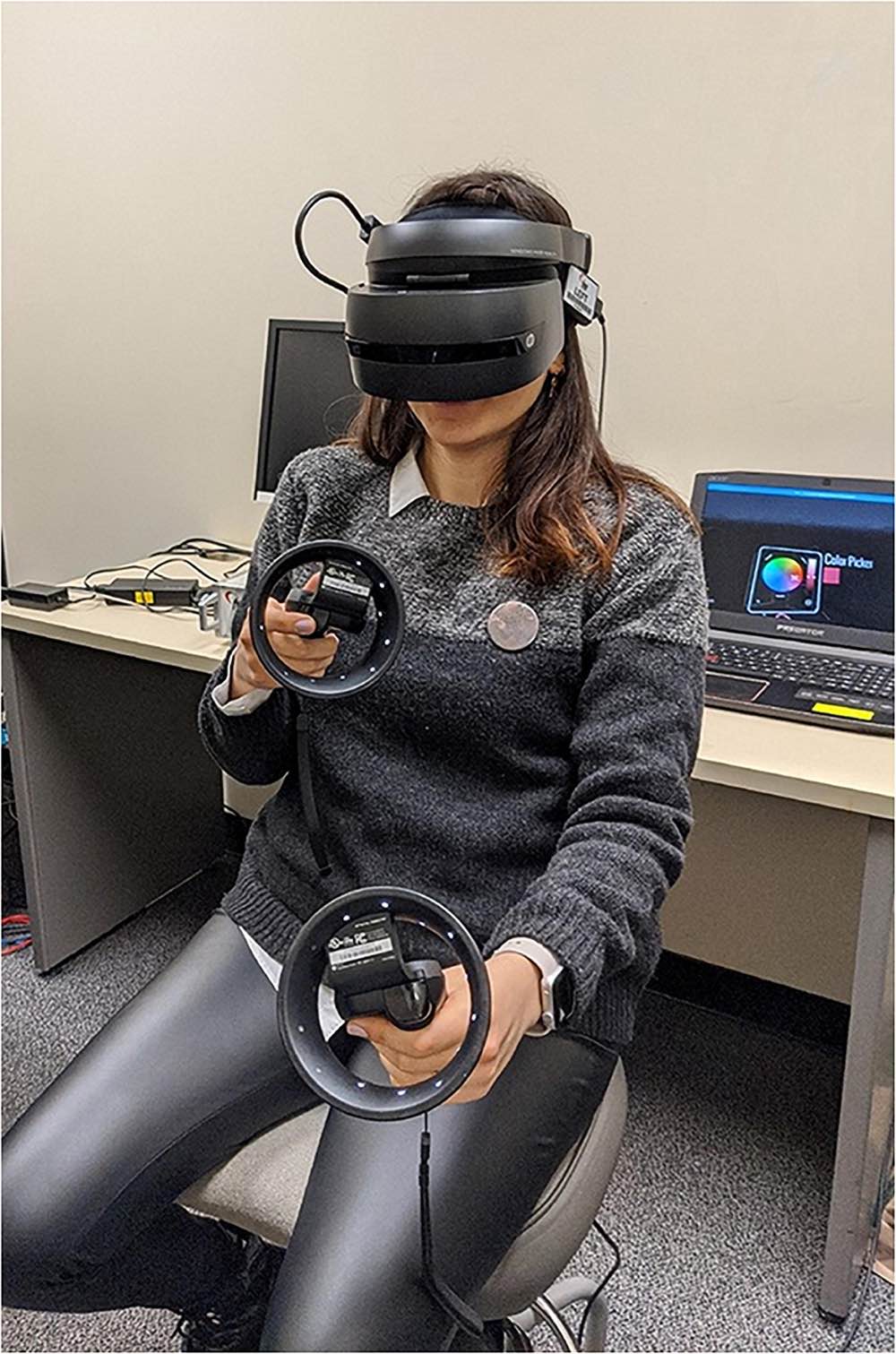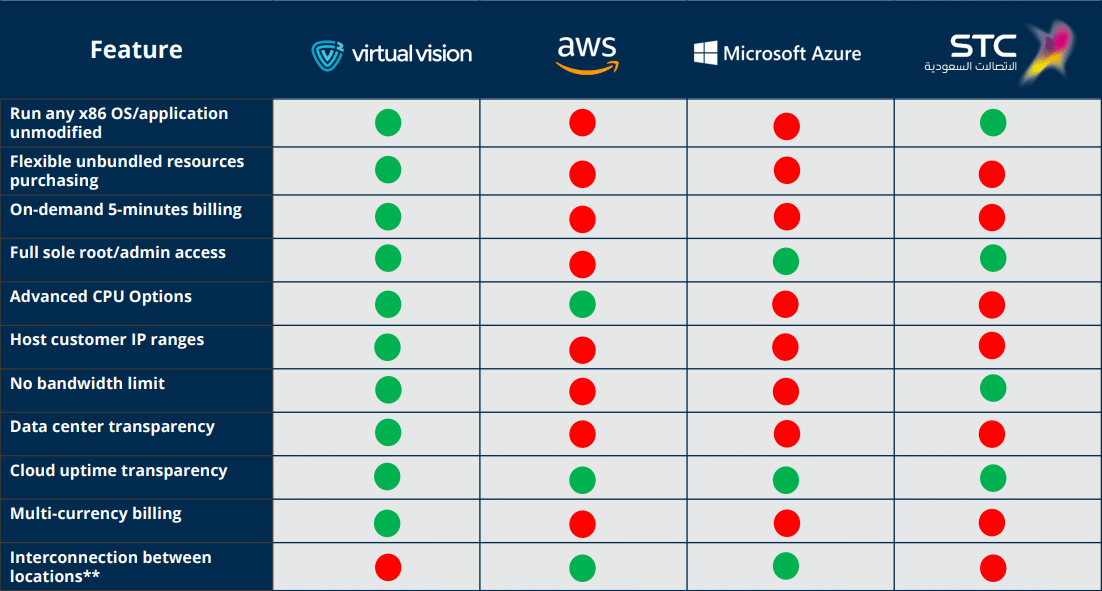Why V2 Cloud
- Localized Service: As a cloud service based in Saudi Arabia, we understand local needs and regulations better.
- Simplicity: Our portal is straightforward and easy to navigate, making your cloud deployment a breeze.
- Flexibility: We offer a cloud service tailored to your terms and configurations.
- Experience: We leverage years of experience as a Local Cloud Service Provider serving customers in Saudi Arabia.
- Independence: We are independent from the ISPs, providing high-speed connectivity while ensuring the security of your information
- Dedicated Support: Our IT staff are available 24/7 to offer assistance whenever you need it.
- Local Network Access: Avoid sharing bandwidth with the entire Internet and bypass the need to send your data around the globe before it reaches your servers.
- Reliability: With a dedicated and experienced IT staff, we can resolve issues promptly.
- Cloud SLA: We provide a Cloud Service Level Agreement (SLA) as a standard.
- Automated Discounts: All discounts are automated, ensuring you get the best possible price.
- Regulatory Compliance: We are always updated with new Saudi regulations and operate under Saudi law.

V2 Cloud
Hardware
- Provision and maintenance of servers, storage, and network devices.
- Refresh of servers, storage, and network devices.
- Tape solutions for backup, archiving, and physical storage.
- Firewall solutions and maintenance.
Infrastructure
- Coverage of electricity costs.
- Air conditioning for optimal hardware performance.
- Datacenter maintenance.
- Physical security to ensure the safety of your data. Retail space.
- Uninterrupted Power Supply (UPS).
- Racks and cabling.
Operations
- Significant cost savings by reducing the costs of IT staff by up to 50%.
- Minimization of costs related to downtimes and IT operation blackouts.
Software
- Provision and maintenance of servers, storage, and network devices.
- Refresh of servers, storage, and network devices.
- Tape solutions for backup, archiving, and physical storage.
- Firewall solutions and maintenance.
Bandwidth
- Coverage of costs related to electricity, air conditioning, datacenter maintenance, physical security, retail space, UPS, and racks and cabling.
Benefits of V2’s Public Cloud
- Connected to Saudi Telecom Company (STC), Mobily, and Integrated Telecom Company (ITC)
- Certified By CTIC as Class (C), The highest Class rating for Cloud Services Provider
- Full audit trail built-in and cannot be deleted
- Access control built-in preventing employees from having improver access
- Two-Factor authentication preventing non-IT staff from accessing the cloud portal
- All data is encrypted, and customers can apply their own encryption with no additional cost
- Payment Card Industry Data Security Standard Complaint (PCI DSS) - Financial Level Security
- ISO 27001 Certified - Certified for privacy and security
- Dedicated international bandwidth (Orange and TATA)
- World-class hardware
V2 Cloud vS Competitors

Product Networking
Billing is based on your resource usage, such as CPU and RAM, which is monitored every five minutes. Should your usage exceed your subscription level, you’ll be billed for the surplus on a rolling five-minute basis. Alternatively, resources can be subscribed for one month, one year, or three years.
Billing cycles are the processes that monitor a customer’s capacity usage on our Cloud and generate the corresponding bill. With V2 Cloud, billing cycles are succinct, lasting only five minutes. This means that any burst capacity usage will be deducted from your account balance in five-minute increments.
You can choose to not purchase any capacity upfront and run on burst, getting billed as you go in short five-minute cycles. Alternatively, subscriptions for resources can be taken out for one month, one year (with a 10% discount), or three years (with a 25% discount).
No worries! Additional usage will simply be billed in short five-minute cycles against your account balance. This process is automatic and doesn’t require any explicit action from you.
Adding a saved payment method allows for automatic account top-ups when funds are low or auto-renewal of subscriptions when they’re due to expire. Note that V2 does not store any credit card information; this is held exclusively by the payment processor.
We enable customers to customize the virtual CPU core for optimal performance across different applications. For instance, a server size of 10GHz could have ten 1GHz cores or four 2.5GHz cores, among other configurations. This allows you to enhance performance without incurring additional costs. By default, this feature is set to auto.
Upon completion of the purchasing process, cloud resources are instantly made available to you.
The network backbone operates at a speed of 10GigE.
V2 guarantees a network latency of 1ms or less for data packets between servers within V2’s services and network.
Options include pay-as-you-go, one-month contracts, one-year contracts, and three-year contracts.
V2 Cloud differentiates itself through a focus on five key pillars: legacy support, ease of use, full automation, open-source infrastructure, and organic evolution. We offer a local Saudi Cloud and hosting services akin to international providers, leveraging the experience we’ve gained since 2010. Our focus extends beyond simply providing a Cloud service, encompassing customer vision, design, implementation, support, and managed services. Our solutions are designed to reduce IT system management costs, modernize applications, manage hybrid environments securely, and match your specific business requirements. Enjoy unrestricted OS options, modern APIs for resource provisioning and configuration, low latency, worldwide connectivity, and unbundled resource payments. Our infrastructure is hosted locally in a world-class Tier III design Data Center, ensuring high resiliency and 100% uptime. Any downtime over 15 minutes is compensated with up to 50 times credits. We guarantee a maximum internal latency of 1ms in our clouds.
While the availability of SOC & NOC services depends on various factors, we do offer them on a case-by-case basis.
Yes, we do provide managed services for Infrastructure as a Service (IaaS) and Security.
We offer two billing models: subscription and burst. Subscriptions are prepaid, while burst charges accrue as you use. Subscriptions are ideal for consistent requirements, while burst purchasing suits temporary needs. Any usage above your subscription level is automatically charged as burst, allowing a combination of both models.
No, only running resources are counted towards your resource subscription level. After shutting down, CPU and RAM usage are not counted, but persistent resources like storage continue to incur charges.
Yes, subscriptions can be layered. If your needs increase over time, you can buy an additional subscription on top of your existing ones.
We accept bank transfers, Visa, Mastercard, American Express, and Paypal. Account balances usually update in real-time (bank transfers after funds clear). Initial payments on new accounts may take up to a few hours to process.
While subscriptions are not set to auto-renew by default, this feature can be enabled for convenience.
Yes, you can select Saudi Arabia Riyal (SAR), Swiss Francs (CHF), United States Dollars (USD), Euros (EUR), or British Pounds (GBP) as your preferred currency when you open your account.
The transition is seamless; simply add funds before the trial period expires to upgrade to a full-paying account. We recommend cloning your drives and restarting your cloud servers after the upgrade for enhanced security.
Migration methods depend on customer workloads. We assess customer environments and recommend the most suitable migration option accordingly.
Please refer to this URL for detailed information: https://ruh.cloudsigma.com/ui/4.0/sla.
Virtual Vision offers cutting-edge technologies, services, products, and local hosting to the untapped markets of Saudi Arabia, in partnership with leading companies in respective fields. Our company is a Saudi Cloud Service Provider and Local Cloud Hosting of innovative solutions, specializing in business and information technology. We also offer general contracting, staffing, and security services.
V2 Cloud utilizes the KVM and VMware Hypervisors.
Yes, you can upload your customized image.
The migration strategy is tailored to customer workloads. After assessing the customer’s environment, we provide the best migration option.
Backup solutions are determined based on customer workloads. We assess the customer’s environment and recommend the most appropriate backup option.
Yes, two-factor authentication (2FA) can be enabled to access the V2 Cloud portal.
Integration methods depend on customer workloads. We assess customer environments and recommend the most suitable option.
Yes, we have established information security policies.
We utilize VLANs and KVM’s traffic separation layer at the boundary of each Cloud VM to ensure data separation. V2 Cloud employs the open-source KVM hypervisor to separate all traffic between client accounts below the virtual machine level. No end-user can view traffic from any other end-user, achieved through a full packet inspection of all incoming and outgoing packets to VMs by Linux KVM. KVM implements a virtual switch for every networking interface of each VM. Acceptable traffic routes, such as other VMs in the user’s account, are established on boot and updated as VMs are added and removed from various networks, including end-user private networks in the local Cloud.
